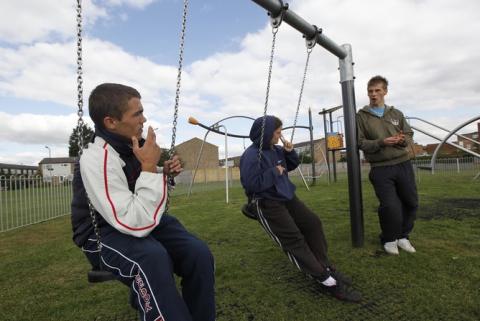You are here
Is there a link between youth poverty and crime? The answers may surprise you

Young people without work in 2009. Eddie Keogh/Reuters
Today, for a substantial minority of 16- to 24-year-olds, to be young is to be workless, poorly paid or just plain poor. Young people in this age group are among the most disadvantaged in the UK, according to a disturbing new report from the Equality and Human Rights Commission (EHRC).
But despite economic and other hardships this young generation appears not to have been pushed into crime.
Some of the headline findings from the EHRC’s Is Britain Fairer report convey the gravity of the declining prospects for young people between 2008 and 2013, during and after the recessions triggered by the global financial crisis. Those aged 16 to 24 experienced the highest unemployment rates and the highest increase in unemployment.
More than one in five of those able to work did not have a job in 2013. Alongside this, some of the biggest declines in pay were experienced by 16- to 24-year-olds – a 60p/hour fall to £6.70. And almost a third of 16- to 24-year olds lived in poverty, compared with one in five 25- to 34- year-olds.
The same young group is significantly more likely than older groups to be stopped and searched by the police. And they are the most frequent victims of violence and sexual violence.
Young people, poverty and crime
But the report offers no data to suggest that they are also committing more crimes. This runs contrary to the so-called “economic causes of crime” thesis, which claims that unemployment is linked to crime, especially when large numbers of people are out of work.
Not only does the report find no evidence of this: it overlooks the dramatic observed decline in crime among young people. According to the Youth Justice Board, the number of those aged up to 20-years-old who were sentenced almost halved from over 90,000 to less than 50,000, step-by-step, year-by-year, over exactly the same period covered in the EHRC report.
Understanding the relationship between being without work (or living in poverty) and crime has been the focus of a century of research. The economic causes of crime thesis is strongly contested, and the extremes of poverty and unemployment in the EHRC report are a powerful empirical stress test of its credibility. If either extreme were prone to triggering crime, it would have done so over this period. Not only did this not occur: the recessions apparently had the opposite effect.
To supporters of the thesis (and some agnostics) this is a paradox. More unemployment and poverty coincided with less crime.
Can we believe the data?
To explain this, one approach is to look at the data available to the EHRC on unemployment as it drew up its report. There are good reasons to believe that the report may understate young people’s problems. But there are significant issues with the crime figures, too.
First, the report pays no attention to the incremental removal of welfare benefits for 16- to 24-year-olds, as the age thresholds at which they were entitled to benefits incrementally shifted upwards. Second, its evidence omits the next stratum of low pay which shows that 72% of 18- to 21-year-olds earn below the “living wage”.
Third, it ignores the unreliability of data regarding the numbers of young people not in education, employment or training (NEET): in many areas the first post-school “destinations” of between one-in-five and two-in-five 16- to 18-year olds are unknown. Young people easily disappear below the radar for all statistical purposes, and go uncounted as the extent of their contact with official agencies declines, partly due to local authority budget cuts. The various poverty and “inactivity” counts are therefore almost certainly considerable underestimates.

How accurate are the crime statistics for young people? Handcuffs via Alexander Raths/www.shutterstock.com
But the crime figures I have quoted above from the Youth Justice Board also appear to represent substantial under-recording of crimes committed by 16- to 24-year-olds.
The crime figures are based on police-recorded crime that results in a conviction, whereas victim-reported crime is a higher estimate that is widely regarded as more representative. Police targets were also adjusted in 2005 to reduce the number of under-18s entering the criminal justice system for the first time. And in 2010, another policy shift led to an increased emphasis on informal responses to crimes committed by young people, in an extra effort to minimise the numbers who have criminal records, thereby further reducing police-recorded crime rates.
Additionally, in 2014, the Office for National Statistics raised serious doubts about police data recording and checks, and the quality of police statistics.
Underestimation
All in all, the official counts of unemployment and of poverty are almost certainly significant underestimates, but so are the crime figures. The data is simply not sufficiently comprehensive, reliable and consistent over time to be sure.
Whether or not the economic causes of crime thesis is right with regard to young people during this period remains entirely unclear. What is certain is that it would take major change and resourcing to improve the data well enough to determine whether corresponding trends between unemployment, poverty and crime could demonstrate convincing causal connections between them.
Other lines of investigation and analyses might prove much more informative – such as those concerning the ways in which some of the most disadvantaged and vulnerable young people become criminalised.
Originally published in The Conversation: https://theconversation.com/is-there-a-link-between-youth-poverty-and-crime-the-answers-may-surprise-you-50097
Ross Fergusson, Senior Lecturer in Social Policy, The Open University
